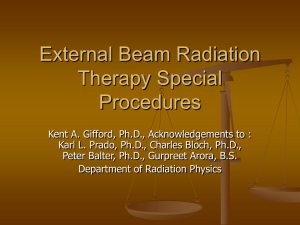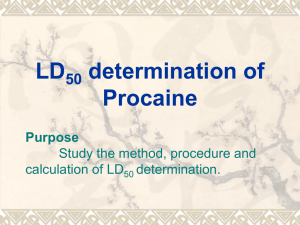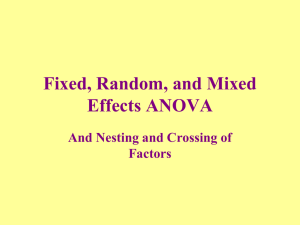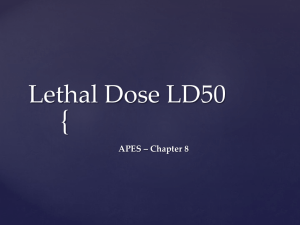leon levin SAPRAA presentation Nov 2011
advertisement
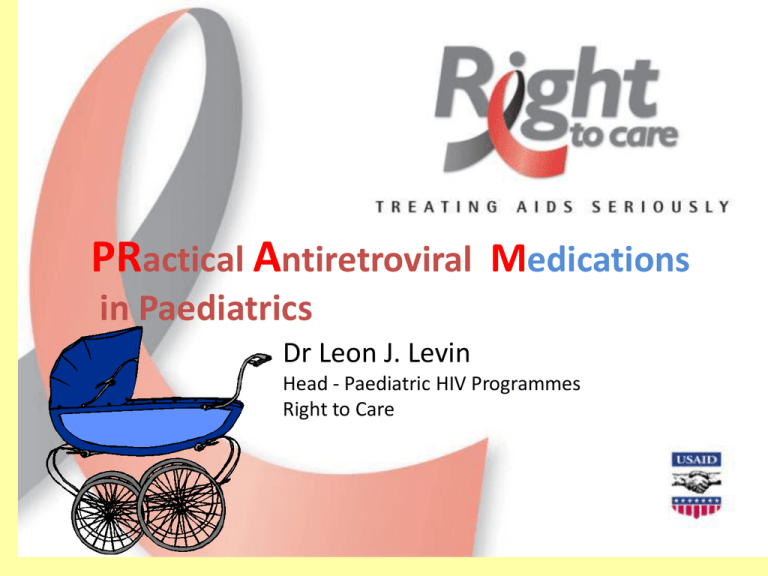
PRactical Antiretroviral Medications in Paediatrics Dr Leon J. Levin Head - Paediatric HIV Programmes Right to Care New Regimens for DOH and Private Sector in SA 0-3 years 1st Line 2nd Line >3years and >10 kg Abacavir (ABC) Lamivudine (3TC) Kaletra® Abacavir (ABC) Lamivudine (3TC) Efavirenz Expert advice Zidovudine (AZT) DDI Kaletra® FIRST LINE • 3TC/ABC/Kaletra • 3TC/ABC/EFV Abacavir +3TC Backbone • Can’t use Tenofovir routinely in children because of osteopaenia and nephrotoxicity • Very good long term data from PENTA 5 • Spares Thymidine analogue for next regimen • Volume of solution is same for both drugs eg 4ml bd • Can be given once daily in > 3 years IMPAACT P1060 • 452 children ages 2 to 35 months from India, Malawi, South Africa, Tanzania, Uganda, Zambia and Zimbabwe. • Cohort 1: 164 children SD NVP at birth • Cohort 2: 287 children who did not receive SDNVP • Children in each cohort were randomly selected to receive AZT/3TC/NVP or AZT/3TC/LPV/r IMPAACT P1060 Cohort 1 (SD-NVP) • 2009, interim review showed that the LVP/r-based regimen was more effective than the NVP-based regimen in children previously exposed to SD-NVP. Cohort 2 (No SD-NVP) NEJM. 14 Oct 2010 • study defined failure occurred in : – 40.1% of children taking the NVP-based regimen – only 18.6% of children taking the LPV/r-based regimen 3TC,Lamivudine Lamivudine ADVERSE EFFECTS Headache Fatigue Nausea Diarrhoea Skin rash Abdominal Pain Pancreatitis Peripheral neuropathy Neutropaenia Elevated Liver enzymes Lactic acidosis Pure Red Cell Aplasia Lamivudine DRUG INTERACTIONS TMP/SMX increases 3TC levels 3TC resistance delays or reverses ZDV resistance Do not administer together with FTC SPECIAL INSTRUCTIONS Can be given with or without food Store at room temperature Lamivudine Lamivudine ( 3TC) 3TC Previous DOSAGES Neonates 2 mg/kg/dose 12 hourly Paediatrics ( >1 month) 4mg/kg/dose 12 hourly Adolescent/Adult BW>50kg 150mg 12hrly BW<50kg 4mg/kg/dose 12 hourly Lamivudine Lamividine • At what weight should we change to adult tabs? • 150÷4=37.5kg • WHO 25kg • Some experts from 20kg 3TC dosage • Don't know if lower exposure to 3TC in < 6yrs is related to reduced virological activity of 3TC containing ART • Don't know effects of lower 3TC exposure on intracellular concentrations • Prudent to aim for higher dose especially in <6 years until more data Can 3TC and Abacavir be given once daily? • • • • • • • • • • • Standard adult dosage 3TC 300 mg once daily & Abacavir(ABC) 600mg once daily, Few data regarding once-daily administration of 3TC & ABC in children. PENTA-13 trial HIV-infected children 2 to 13 years of age PENTA 15 trial children 3 to 36 months of age Both trials were crossover design with doses of lamivudine of 8 mg/kg/once daily or 4 mg/kg/twice daily and ABC 16mg/kg/dose once daily or 8mg/kg/dose bd. Area under the curve (AUC)0-24 and clearance values were similar and most children maintained an undetectable plasma RNA value after the switch. Arrow Trial substudy. 41 children 3 to 12 years of age (median age 7.6 years) in Uganda Stable on twice-daily 3TC and ABC- switch to once-daily3TC & ABC, with median follow-up of 1.15 year. Equivalent (AUC)0-24 and good clinical outcome (disease stage and CD4 cell count) after a switch All three studies enrolled only patients who had low viral load or were “clinically stable” on twice-daily 3TC & ABC before changing to once-daily dosing Therefore, some experts support switching to once-daily dosing of 3TC & ABC in clinically stable patients with undetectable viral load and stable CD4 cell count, (USA) Others support the use of once daily 3TC ABC from age 3 years (PENTA) Antivir Ther. Antivir Ther. 2010;15(3):297-305., Antivir Ther. 2010;15(8):1115-1124. 2005;10(2):239- Lamivudine DOSAGE Neonates Lamivudine ( 3TC) 3TC 2 mg/kg/dose 12 hourly Paediatrics ( >1 month) 4-6 mg/kg/dose 12 hourly (aim for higher dose) From 3 years can give 8-12mg/kg/dose once daily Change to full adult dose at 25kg (some say at 20kg) Adolescent/Adult 150mg 12hrly Or 300mg OD Abacavir Abacavir ADVERSE EFFECTS Nausea and vomiting Fever headache Diarrhoea Hypersensitivity Reaction Lactic Acidosis Pancreatitis Liver enzymes Blood glucose Triglycerides Abacavir Hypersensitivity Reaction • • • • • What is a Hypersensitivity Reaction? An Allergy Has anyone ever died of Penicillin Allergy? Do we still use penicillin? Has anyone ever died of Abacavir Hypersensitivity Reaction? • No • But there have been deaths from rechallenging with Abacavir after a reaction Abacavir Hypersensitivity Reaction • Therefore • If you stop Abacavir for a suspected Hypersensitivity reaction, you can NEVER give the patient Abacavir again Abacavir Hypersensitivity Reaction • • • • • • • • • Fever Malaise, Aches Rash Vomiting Diarrhoea Abdominal pain Cough Dyspnoea Sore throat Symptoms • Multi system disorder • Usually occurs within 6 weeks of starting ABC Abacavir Hypersensitivity Reaction • • • • • • • Differential Diagnosis Measles Influenza Pneumonia Streptococcal Pharyngitis Scarlet Fever TB IRIS Abacavir Hypersensitivity Reaction Incidence • Hypersensitivity linked to HLA B*5701 • HLA B*5701 rare in Black population • HSR 5% in whites, 0.2% in Blacks Abacavir DRUG INTERACTIONS No significant interactions with other ARVs Ethanol ABC levels SPECIAL INSTRUCTIONS Can be given without regard to meals Warn patient about Hypersensitivity Reaction Don’t stop ABC until discussed with HCW Do NOT rechallenge with ABC after Hypersensitivity Reaction Therapy should not be interrupted and then restarted Abacavir • At what weight should we change to adult tabs? • 300÷8=37.5kg • WHO 25kg • Some experts from 20kg DOSAGE Abacavir 0-3 months No data Paediatrics/Adolescents >3 months 8-10mg/kg/dose bd (max 300mg bd) 16-20mg/kg/dose once daily in > 3years (Max 600mg daily) Adult dose from 25kg (some say from 20kg) 300mg bd or 600mg daily Adult dose Kivexa ® • Fixed dose Combination tablet 3TC & Abacavir • 300mg 3TC/600mg Abacavir per tablet • Dose: 1 tablet once a day • Very large tablet • Use from 20kg if child can swallow it • Expensive Stavudine Stavudine ADVERSE EFFECTS Headache, GI disturbance, Skin Rashes Peripheral neuropathy, Pancreatitis, Lactic Acidosis LIPOATROPHY SPECIAL INSTRUCTIONS Can be administered with or without food Decrease dose with renal impairment Oral solution needs refrigeration Oral solution stable in fridge for 30 days Powder from capsules stable in water for 24 hours Do not administer together with ZDV Stavudine (d4T) Zerit BMS DOSAGE Neonatal birth to 13 days 0.5mg/kg/dose 12 hourly Paediatrics > 14 days (up to 30 kg) 1mg/kg/dose 12 hourly Adolescent/Adult 30mg 12 hourly Lopinavir/ritonavir Lopinavir/ritonavir PREPARATION Adult dose Oral solution 80mg LPV & 20mg RTV per ml Aluvia 200/50 200mg LPV and 50mg RTV per capsule 2 tabs bd Aluvia 100/25 100mg LPV and 25mg RTV per capsule 4 tabs bd Lopinavir/ritonavir DRUG INTERACTIONS Numerous interactions due to potent inhibition of Cytochrome P450 CYP3A4 by RTV Check every drug that patient is on for interactions with LPV/RTV Interactions as for Ritonavir EFV & NVP serum concentrations of LPV/RTV. dose of LPV/RTV . Interactions with other PIs. Appropriate doses not established. Solution contains 42% alcohol. Avoid Disulphuram or metronidazole. What is the Dose of Kaletra®/Aluvia® • Ideally Children < 2 years should receive a dose of LPV of 300mg/m2 • Some paediatricians use a dose of LPV of 300mg/m2 in all paediatric patients • Dont don't exceed 400mg LPV (unless on concomitant NNRTI (not > 500mg LPV)) • WHO recommends 230-350mg/m2/dose bd • Rather aim for upper end of range especially in younger children Infants < 6 months of Age Infants < 6 months of Age 300/75 mg/m2/dose LPV/r provides similar exposure to that seen in older children, albeit slightly less than seen in adults No data in infants < 14 days of age AIDS 2008, 22:249–255 What about premature infants? What about premature infants? • Kaletra oral solution contains 356.3 mg/mL (42% v/v) ethanol and 152.7 mg/mL propylene glycol. • LPV is metabolized by CYP3A; both ethanol and propylene glycol are initially metabolized by alcohol dehydrogenase. • Reduced hepatic metabolism and renal clearance in newborns, especially preterm infants, can lead to accumulation of all 3 ingredients. • Propylene glycol toxicity can cause bradycardia and cardiac arrhythmias, central nervous system (CNS) depression, acute renal failure, and lactic acidosis. • Acute ethanol toxicity can lead to AV block, cardiac arrhythmias, CNS depression, and lactic acidosis. • LPV has been associated with cases of heart block, and PR and QT interval prolongation. • Cases of toxicity in neonates, mostly premature, have been reported to FDA. CROI 2011. Poster 708 • • • • • • • • • • • What about premature infants? Methods: Searched the FDA Adverse Event Reporting System (AERS) for all reports of toxicity in children ≤2 years of age after administration of Kaletra oral solution. Results: Found 10 cases in neonates, 8 of whom were premature. The gestational age was between 28 and 35 weeks in infants born prematurely. Documented events included cardiac toxicity (bradycardia, complete AV block, bundle branch block, or cardiac failure; n = 7), acute renal failure (n = 5), increased serum creatinine (n = 1), elevated serum lactate level (n = 2), hyperkalemia (n = 4), respiratory failure (n = 2), hypotonia (n = 1), abnormal EEG (n = 1), and CNS depression (n = 1). Acute overdoses were described in 2 cases, 1 resulting in death. Therapy was initiated on the day of birth in 7 neonates, day after birth in 1, day 34 in 1, and unknown in 1. Onset of symptoms occurred within 1 to 6 days (n = 8); discontinuation of Kaletra resulted in clinical improvement within 1 to 5 days (n = 6). Conclusions: This case series shows that premature neonates are at increased risk of LPV, ethanol, and/or propylene glycol toxicity associated with Kaletra oral solution administration. CROI 2011. Poster 708 What about premature infants? • RECOMMENDATION: The use of Kaletra oral solution should be avoided in premature babies until 14 days after their due date, or in full-term babies younger than 14 days of age unless a healthcare professional believes that the benefit of using Kaletra oral solution to treat HIV infection immediately after birth outweighs the potential risks. In such cases, FDA strongly recommends monitoring for increases in serum osmolality, serum creatinine, and other signs of toxicity. Can Kaletra be given once daily in children • Adult data conflicting • Some studies suggest only effective in PI naive patients with low viral loads • Adults – only use if < 3 LPV mutations • Paeds- PI says dont use once daily CROI 2008. Poster 775; 11th European AIDS Conference, Madrid, 2007. [Abstract LBPS7/5] ; 11th European AIDS Conference, Madrid, 2007 [Abstract LBPS7/4] Can Kaletra given once daily in Children • • • • • Sample sizes have been small Awaiting KONCERT trial High viral load issue not fully resolved Vomiting seems to be a problem early on Probably best if not done routinely until more data • In selected cases may be appropriate Lopinavir/ritonavir ADVERSE EFFECTS • Diarrhoea,headache,asthenia,nausea & vomiting • Cholesterol & Triglycerides, pancreatitis,hyperglycaemia, hepatitis, Lipodystrophy • Arrythmias SPECIAL INSTRUCTIONS • • • • • • • • • • Administer solution with food Dose solution in ml not mg and Aluvia in tablets not mg Aluvia can be given with or without food (food may enhance tolerabilty) Do NOT crush or halve Aluvia tablets Give ddI 1 hour before or 2 hours after LPV/RTV Solution.Refrigerate. Stable for 6 weeks at room temperature Give a drink straight after dose of solution. Aluvia does not require refrigeration Do not administer to premature babies or infants < 14 days old Once daily dosing generally not recommended DOSAGE Lopinavir/ritonavir Prematures Avoid till 2 weeks after due date Neonates No data < 14 days. Avoid Paediatrics 230mg/m2/dose of LPV component 12 hrly Patients > 6 months not on NVP or EFV Paediatrics Infants < 6 months Patients on NVP or EFV Or PI exp 300mg/m2/dose of LPV component 12 hrly Or some say all paediatric patients Adult/Adolescent 400mg of LPV component 12 hrly Patients not on NVP or EFV Adult/Adolescent Patients on NVP or EFV or PI experienced 500mg of LPV component 12 hrly Ritonavir Ritonavir SPECIAL INSTRUCTIONS Only used as a booster or in addition to Kaletra with TB Rx Should never be used as a sole PI High incidence of resistance and cross resistance if used as sole PI Check every drug that patient is on for interactions with RTV If child can swallow capsules give capsule even if dose is high Administer with food Give ddI and RTV 1-2 hours apart Keep oral solution at room temperature Oral solution has 6 month shelf life Terrible taste can be disguised by giving RTV with milk, chocolate milk, vanilla or chocolate pudding, or ice cream.Coating mouth with peanut butter. Give maple syrup,cheese or chewing gum after dose. Ritonavir ADVERSE EFFECTS Nausea, Vomiting , Diarrhoea & abd pain Headache anorexia circumoral paresthesias Liver enzymes Pancreatitis Cholesterol and Triglycerides Hyperglycaemia Lipodystrophy (RTV) Norvir Ritonavir Abbott DOSAGE With comcommitant TB Rx- ¾ Kaletra volume As PI booster-Depends on PI being boosted Generally 100mg bd or daily If child can swallow capsules give capsule even if overdose Efavirenz Adverse effects Efavirenz Skin Rash CNS effects • Insomnia,somnolence,nightmares,confusion, amnesia, hallucinations,agitation,euphoria Raised Liver enzymes Teratogenic in monkeys (and humans) Lipomastia SPECIAL INSTRUCTIONS Supposed to be given on empty stomach but can generally be taken with or without food providing it is tolerated well. Avoid high fat meals ( Absorption) Capsules may be opened and added to soft foods. (Peppery taste) Tablets cannot be crushed. Use generic capsules if child cant swallow tablets Bedtime dosing especially 1st 2-4 weeks No data in children < 3 years and < 10kg Efavirenz DRUG INTERACTIONS • mixed inducer/inhibitor of Cytochrome P450 CYP3A4 (More Inhibitor) • concentrations of concomitant drugs can be increased or decreased depending on the specific enzyme pathway involved. There are multiple drug interactions with efavirenz. • Before efavirenz is administrated, the patient’s medication profile should be carefully reviewed for potential drug interactions with efavirenz. Contra-indicated ,terfenadine,midazolam,triazolam,,cisapride, ergot alkaloids Monitor carefully. Warfarin, ethinyl oestradiol Rifampicin, phenobarb, phenytoin may decrease EFV levels. Significance unknown Can still use EFV with TB treatment EFV deceases Clarithromycin levels & increases its metabolite. Rather use Azithromycin with EFV PI’s .EFV decreases levels of LPV and ATV. Therefore increase dose of LPV and only use RTV boosted ATV Efavirenz EFV Stocrin MSD DOSAGE Paediatric Dose (> 3 years) Adult /Adolescent dose 15mg/kg/dose nocte or 10- <15kg 200mg nocte 15- <20kg 250mg nocte 20- <25kg 300mg nocte 25-<32.5kg 350mg nocte 32.5-<40kg 400mg nocte >= 40kg 600mg nocte 600mg nocte Efavirenz EFV Stocrin MSD New WHO DOSAGE Paediatric Dose (> 3 years and > 10kg) 10- <15kg 200mg nocte 15- <25kg 300mg nocte 25-<35kg 400mg nocte > 35kg 600mg nocte Adult /Adolescent dose 600mg nocte Weight based vs Body Surface Area BSA based • Some drugs weight based eg 3TC,ABC,EFV • Some drugs BSA based eg LPV/r,NVP,AZT • BSA dosages more accurately follow growth of child • Weight based dosage Charts reasonably accurate and very convenient • Use weight based dosages except in special circumstances eg 3rd line, resistant virus, pt on rifampicin Weight Base Dosage Chart Weight Base Dosage Chart Advantages • Only requires weight • Doses rounded off Disadvantages • Developed for Western Cape – not necessarily ideal for rest of SA • Not that accurate for BSA dosed drugs • Different doses morning and evening may impact on adherence • Not all dosage forms catered for e.g. tabs and syrup Weight Base Dosage Chart • Needs work • Use should be encouraged especially with inexperienced nurses and doctors • Meeting of DOH and HIV Clinicians Society 2 December to discuss Conclusion • Keep things simple • Accurate doses vs simplicity and ease of use • With post marketing research very often Package insert doses are no long reliable • Things aren't always as clear as they seem • Consult a recent good guideline Zidovudine Zidovudine AZT,ZDV) - Retrovir GlaxoSmithKline DOSAGE Premature infants <35 1.5mg/kg/dose(ivi) or 2mg/kg/dose po 12 hourly. Inc to 8hrly at 2 weeks(> 30 weeks weeks) or 4 weeks (<30 weeks) Neonates (< 6 weeks) 2mg/kg/dose po 6hrly or 4mg/kg/dose 12 hourly Paediatrics 180-240mg/m2 /dose 12 hrly Adolescent/Adult 300mg 12 hourly Didanosine Didanosine SPECIAL INSTRUCTIONS Buffered Tablets Tablets can be chewed or dispersed in 30ml of water or clear apple juice Administer tablets on empty stomach ½ hour before or 1 hour after a meal Tablets contain Buffer. Always give at least 2 tablets together to get the right dose of buffer Give Lopinavir/ritonavir 1 hour after or 2 hours before ddI Limited data for once daily dosing in children but does aid adherence Solution Oral solution needs to be reconstituted with antacid. Shake well. Is stable for 30 days in Fridge EC capsules Must still be given on empty stomach Can be given together with Aluvia tablets on an empty stomach Kaletra solution must still be separated from Videx EC by 1-2 hours Didanosine DRUG INTERACTIONS ddI serum concentrations are increased when ddI is coadministered with TDF. Avoid this combination if possible Mitochondrial toxicity increased if given with d4TAVOID Absorption of Tetracyclines & Fluoroquinolines. Separate by 2 hours ddI Absorption of Protease Inhibitors. Separate by 1-2 hours or use EC ddI DOSAGE Didanosine (ddI) Videx BMS Neonates (2 weeks to <3 months) 50mg/m2/dose 12hourly Infants 3 months to 8 months 100 mg/m2/dose 12hourly Paediatrics 90–150mg /m2/dose 12 hourly Some experts give 180300 mg/m2/dose once daily Adolescent/Adult BW>60kg 400mg once daily BW<60kg 250mg once daily Tenofovir ADVERSE EFFECTS Osteopaenia Renal toxicity Tenofovir • FDA USA and WHO advocate using TDF from 12 years and 35kg • USA DHHS guidelines age 12 and > Tanner stage IV • SA package insert- from 18 years • Most experts are reluctant to use it routinely in children so young. • Best to reserve for patients with resistance or Hep B > 12years or routinely from 18 years NNRTIS Nevirapine Nevirapine • • • • • • , SPECIAL INSTRUCTIONS Can be administered with or without food Can be given concurrently with ddI Rash normally occurs in 1st 6 weeks If rash occurs, do not increase dose until rash resolves Discontinue with severe rash or constitutional symptoms • Monitor liver functions 2 weekly for the first 8 weeks and 3 monthly thereafter • If child reaches 8years, don’t decrease the dose. Let the child grow into the correct dose • If NVP dosing is interrupted for more than 7 days, restart with once-daily dosing for 14 days and increase if rash resolved Nevirapine DRUG INTERACTIONS Induces Cytochrome P450 CYP3A Therefore numerous potential interactions Before nevirapine is administered, the patient’s medication profile should be carefully reviewed for potential drug interactions with nevirapine Rifampicin -lowers NVP levels significantly. Don’t use together Anticonvulsants – monitor levels Oral contraceptives –use other means of birth control Don’t use NVP together with Atazanavir boosted or unboosted Nevirapine DOSAGE Neonates prophylaxis Paediatrics > 15 days Adolescent/Adult BW <2.5kg BW> 2.5kg 1ml daily 1.5ml daily Age < 8 year 200mg /m2 /dose 12 hrly Age >8 year 120-150mg /m2 bd . Start daily X 14 days then increase to full dose 200 mg daily X 14 days , then 200mg 12 hrly Protease Inhibitors (PIs) Atazanavir Drug interactions Atazanavir • ATV is both a substrate and an inhibitor of the CYP3A4 enzyme system and has significant interactions with drugs highly dependent on CYP3A4 for metabolism. • There is potential for multiple drug interactions with atazanavir. . • Before atazanavir is administered, the patient’s medication profile should be carefully reviewed for potential drug interactions with atazanavir. • Tenofovir decreases atazanavir plasma concentrations. Only ritonavirboosted atazanavir should be used in combination with tenofovir. • NNRTIs: Efavirenz, etravirine, and nevirapine decrease atazanavir plasma concentrations significantly. Nevirapine and etravirine should not be coadministered to patients receiving ATV . Efavirenz should not be coadministered with atazanavir in treatment-experienced patients but may be used in combination with atazanavir 400 mg plus ritonavir boosting in treatment-naive adults. • Atazanavir absorption is dependent on low gastric pH. When atazanavir is administered with medications that alter gastric pH, dosage adjustment is indicated Special Instructions Atazanavir • Generally only use boosted with RTV esp in children< 13 years • Administer ATV with food to enhance absorption. • Use ATV with caution in patients with pre-existing cardiac conduction system disease or with other drugs known to prolong the PR interval (e.g., calcium channel blockers, beta-blockers, digoxin, verapamil). • ATV absorption is dependent on low gastric pH; therefore, when ATV is administered with medications that alter gastric pH, special dosing information is indicated • Give ATV at least 2 hours before or 1 hour after antacid or ddI tablet administration. • Only RTV-boosted ATV should be used in combination with TDF or EFV • Nevirapine and etravirine should not be coadministered to patients receiving atazanavir (with or without ritonavir Atazanavir Dosages AGE weight Dosage given with food Neonates Dont administer to neonates because of risks associated with hyperbilirubinemia (kernicterus) Paediatric: 6 - 18 years 205 mg/m2 OD Adolescent (≥18–21 years of age)/adult dose: 15 - <25 kg ATV 150mg + RTV 80 mg OD 25 - <32 kg ATV 200mg + RTV 100 mg OD 32 - <35 kg ATV 300mg + RTV 100 mg OD >35 kg ATV 300 mg+ RTV 100 mg OD Antiretroviral-naive patients: ATV 300 mg + RTV 100 mg OD or ATV 400 mg OD Antiretroviral-experienced patients: ATV 300 mg + RTV 100 mg OD ATV +EFV adults in therapy-naive patients only: ATV 400 mg + RTV 100 mg + EFV 600 mg OD Conclusion • Keep things simple • Accurate doses vs simplicity and ease of use • With post marketing research very often Package insert doses are no long reliable • Things aren't always as clear as they seem • Consult a recent good guideline Practical Resources • SA HIV Clinicians Society – http://www.sahivsoc.org/ – sahivsoc@gomail.co.za • Right to Care Paediatric ARV Helpline – 0823526642 • Dr Leon Levin leon.levin@righttocare.org • SA HIV Clinicians Paeds Guidelines http://www.sajhivmed.org.za/index.php/sajhivmed • American Guidelines www.aidsinfo.nih.gov • PENTA (European) Guidelines www.ctu.mrc.ac.uk/PENTA • WHO Guidelines www.who.int DOH Guidelines http://www.doh.gov.za/docs/hiv-f.html • Liverpool drug interactions Website: www.hiv-druginteractions.org


